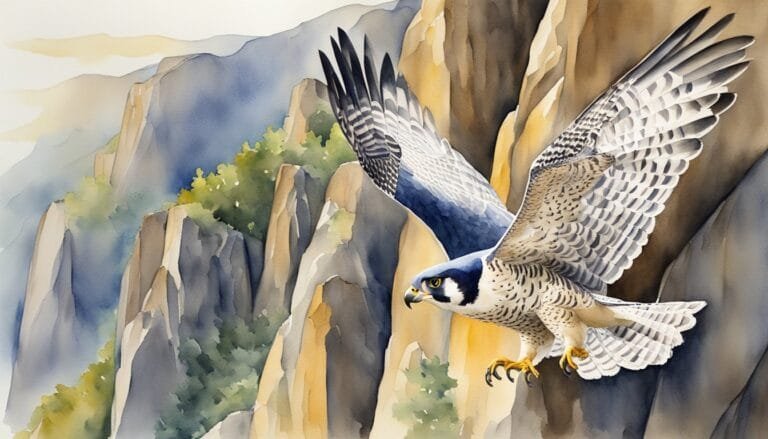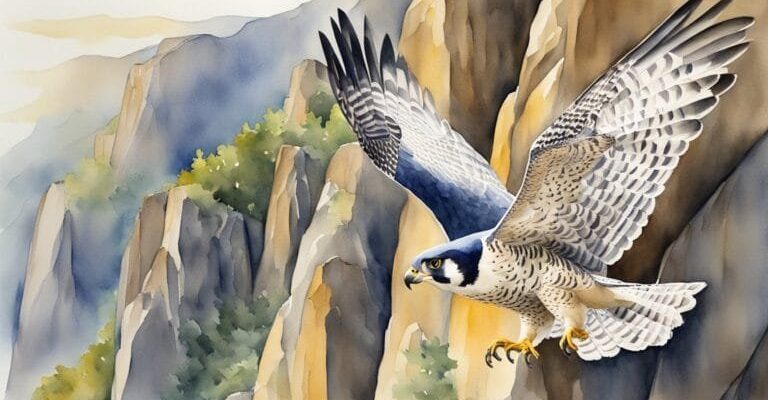
Let’s take a look at the places where peregrine falcons thrive. From urban skyscrapers to remote cliffs, understanding their habitat brings us closer to these stunning birds. Imagine sipping coffee at a cozy café while pondering over the secrets of nature, and you’ll see how the peregrine falcon fits into our world. This article will guide you through their living spaces, habits, and how distribution varies across the globe.
Understanding Peregrine Falcon Habitat
Peregrine falcons are adaptable birds, thriving in a variety of environments. They can be found on every continent except Antarctica. That’s pretty impressive, right? During the breeding season, these birds prefer open landscapes where they can hunt effectively. Think of rocky cliffs, coastlines, and even urban areas. Their flexibility allows them to nest in high places, like tall buildings or bridges, mimicking their natural cliff-side habitats.
Their preferred habitats not only provide nesting sites but also offer a rich source of food. These falcons primarily feed on other birds, making locations near wetlands, where migratory birds gather, perfect for them. Honestly, they have a knack for finding the best spots—areas with abundant prey and few predators. This is why sightings near rivers, lakes, and coastlines are so common.
Urban Environments: A Surprising Home
You might be surprised to learn that peregrine falcons are *thriving in cities*. The towering skyscrapers and bridges provide ideal nesting spaces similar to their natural cliff habitats. Take New York City, for example. Falcons have made their homes on high-rise buildings, and many people have spotted them diving for pigeons in Central Park. Here’s the thing: urban environments offer plenty of food sources, and these birds have learned to navigate the hustle and bustle of city life.
Additionally, humans have unwittingly helped the peregrine falcon population rebound from near extinction. Conservation efforts, including the installation of nesting boxes on buildings, have allowed these incredible birds to flourish in places they previously avoided. It’s fascinating to think about how these beautiful creatures adapt to their surroundings, making the most of what’s available.
Migration Patterns of Peregrine Falcons
While many peregrine falcons are year-round residents, some are migratory. Those that breed in the northern parts of North America will often migrate south for the winter, seeking milder climates. Their migrations can cover thousands of miles! Imagine flying from the Arctic tundra all the way to the warmer southern states, like Florida or even Mexico. This long-distance travel showcases their incredible endurance.
During migration, these falcons tend to stick to specific routes, often following coastlines or river valleys where they can easily access food and find safe resting spots. These journeys are critical for their survival, allowing them to avoid harsh winter conditions and take advantage of available prey. Watching a peregrine falcon in migration is a reminder of the vastness of nature and the resilience of wildlife.
The Importance of Nesting Sites
Choosing the right nesting site is crucial for peregrine falcons. They typically return to the same location year after year. In remote areas, they nest on ledges of cliffs or in high-altitude locations, while in cities, they look for ledges on tall buildings. These nesting sites are often near open areas where they can hunt.
The choice of site is not just about elevation; it’s also about safety. Nesting on cliffs protects them from ground predators, while urban nests provide protection from some of nature’s threats. You might wonder why they don’t just nest anywhere. The reality is, the site needs to offer the perfect balance of safety, accessibility, and proximity to food sources. Such considerations are essential for raising their young successfully.
Global Distribution of Peregrine Falcons
Peregrine falcons have a remarkable global distribution. They inhabit various ecosystems, from the Arctic tundra to temperate forests. Different populations have adapted to their unique environments, which affects their behavior and hunting techniques. For example, those living in coastal areas may specialize in hunting seabirds, while those in forested regions might focus on songbirds.
In North America, you can find them across the continent, but their presence is denser in specific regions. Urban areas, coastal cliffs, and river valleys are hotspots for these birds. In Europe, they thrive in both rural and urban environments, while in Asia, they can be spotted in mountainous regions and steppes. Their ability to adapt to varying climates and landscapes showcases their resilience and versatility.
Conservation Efforts and Challenges
Despite their adaptability, peregrine falcons have faced significant challenges. In the mid-20th century, pesticide use, particularly DDT, caused severe population declines. Thankfully, aggressive conservation efforts, including habitat protection and reintroduction programs, have led to a remarkable recovery. Today, peregrine falcons are considered a conservation success story.
However, they still face threats, especially as urban areas expand and climate change alters their habitats. Preservation of their nesting sites and food sources remains a priority for conservationists. You might be wondering, how can we help? Supporting local wildlife organizations and advocating for environmentally-friendly practices can make a difference in protecting these wonderful birds.
Peregrine falcons are more than just incredible hunters; they represent resilience and adaptability in our ever-changing world. Their unique habitat preferences, migratory behaviors, and global distribution remind us of the complexity of nature. With urban and remote habitats alike, these birds have found a way to thrive alongside humanity.
As we learn more about where peregrine falcons live, we can better appreciate their role in our ecosystems. By supporting conservation efforts, we can help ensure that future generations will continue to marvel at these spectacular birds. So, the next time you see a falcon soaring through the sky, remember the incredible journey it takes to find its home.

